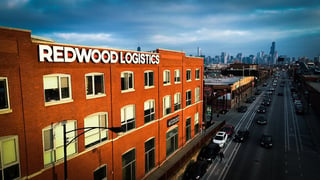REDWOOD LOGIN
Redwood PortalLTL
SCS
SCS Support
Rockfarm

The digital revolution has touched every aspect of our world, and Supply Chain is no exception. Innovation is providing faster, more efficient technologies to change the face of Logistics across every level.
It may come as no surprise to many business owners that tomorrow’s technology has already started to create massive growth opportunities for those jumping on board. With that said, we’re going to cover some of the trends on the rise in the Global Logistics Market.
IoT Technology creates a literal new language for our devices to speak with each other. Data travels at blazing speeds from one device to another without relying on human intervention to send or receive information.
With IoT technology, users can monitor inventory, track shipments, locate drivers via GPS, and restock orders automatically. This flow of information happens in real-time, so there’s no longer a need to rush orders and pay for expensive hotshot trucks because you just found out from your warehouse that your inventory is critically low.
On-site legacy data storage is stubbornly still holding on, but trends show that Cloud technology is the next wave into the future. Cloud Technology provides faster connections, faster data acquisition, and greater visibility among every link in the Supply Chain.
With Cloud Technology, Data travels at the speed of the internet and makes transfers of large files much faster than peer-to-peer data transfers. Cloud-based storage solutions solve storing and maintaining data in-house and the cost and hassle of reproducing data for analytics.
Cloud technology will also be compatible with newer technologies, something legacy-based systems can’t compete with anymore.
There is no question that sustainability has become a crucial issue for every sector, including the Global Supply Chain. In the past, companies could get away with unethical practices or inferior products for the sake of cutting costs. With class-action lawsuits and public outrage becoming more vocal about ‘canceling’ products altogether, businesses can’t afford to ignore sustainability.
Consumers demand more sustainably sourced products and ethical business practices. Regulatory Agencies are beginning to echo this push as well, adopting stricter guidelines and ethical standards.
By incorporating sustainable practices into every level of the supply chain, companies ensure that their company reflects their companies’ vision and avoids getting caught up in unethical practices. Monitoring Carbon footprints, switching to recyclable materials, electric-powered trucks, and powering facilities with solar power are all examples of implementing sustainable practices.
Sustainability will prepare companies to tackle newer challenges as they present themselves in the long run.
API integrations are transforming the logistics landscape.
API can obtain millions of data in minutes and provide accessibility to anyone connected to the system. This accessibility will give greater visibility and grant users the ability to respond to exceptions much faster.
API is also designed to be compatible with future technologies, something its predecessor EDI cannot accomplish.
With the advent of IoT and Cloud technology, big data is here to stay. Big Data is the collection and analysis of real-time data, and with existing technology, this is now achievable.
Companies are using API and Cloud technology to acquire data and analyze it for market trends, analyze performances and exceptions and predict future outcomes.
Big Data is also a key component in the future of Predictive Learning and Artificial Intelligence.
AI has been around for decades and has helped automate tasks to cut costs. What’s important now is the implication of Artificial Intelligence being capable of automating entire productions based on acquired data.
Our future will include AI that can collect data and analyze and create efficient plans and automate processes without human interference.
This technological advancement is only possible with a connected network using IoT, Cloud Technology, and API technology. While technology is not there yet, it’s safe to say it’s well on its way.
Omni-channel means different platforms centered around the customer. This practice has become the norm as customers have opted for faster, more convenient purchases. Customers can choose to shop online, in person, or on their phones and decide how they want to receive their product.
Omni-channel distribution demands integration of shippers, retailers, and 3PLs and open communication channels. This holistic, integrative strategy requires each supply chain section to treat each other as partners and not independent entities. Having connected systems and data acquisition is also critical for omni-channel distribution to work.
With so many companies fulfilling consumer needs via online shopping due to the global pandemic, businesses have to restructure their operations to keep up with customer demands. Omni-channel supply chains are proving to be the new normal of supply chains.
This is the common denominator among every technological trend. They’re all ultimately transforming the supply chain from analog to digital, manual to automatic, human to machines.
Digitizing the supply chain brings together every system to benefit data and information flow. It ultimately creates a system that eliminates siloed information and creates transparency in the supply chain. Digitization will transform every fabric of the supply chain.
These trends are proof that technology is transforming how we do business today. While some companies may resist new software and reject new practices, they may quickly find that they’ll need to change their ways to survive the digital revolution.
The future is here, and companies must shift their sails to the winds of change to stay relevant.